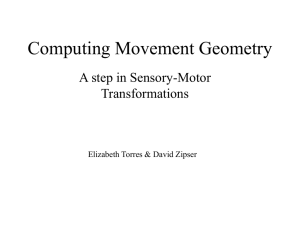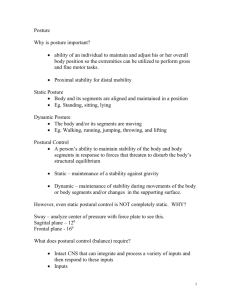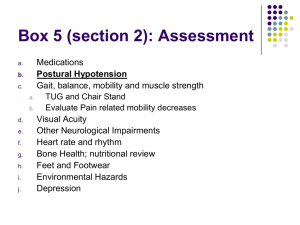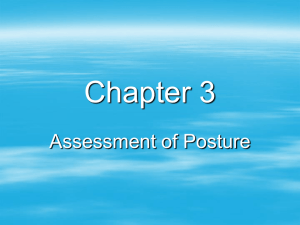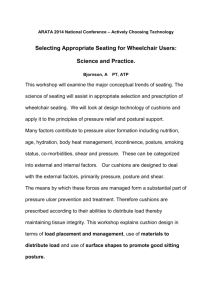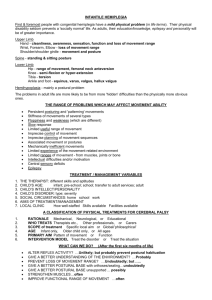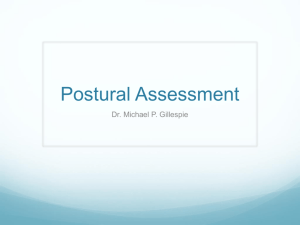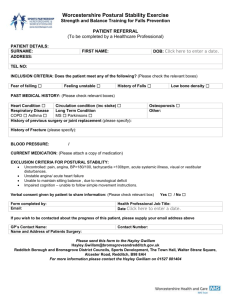File
advertisement
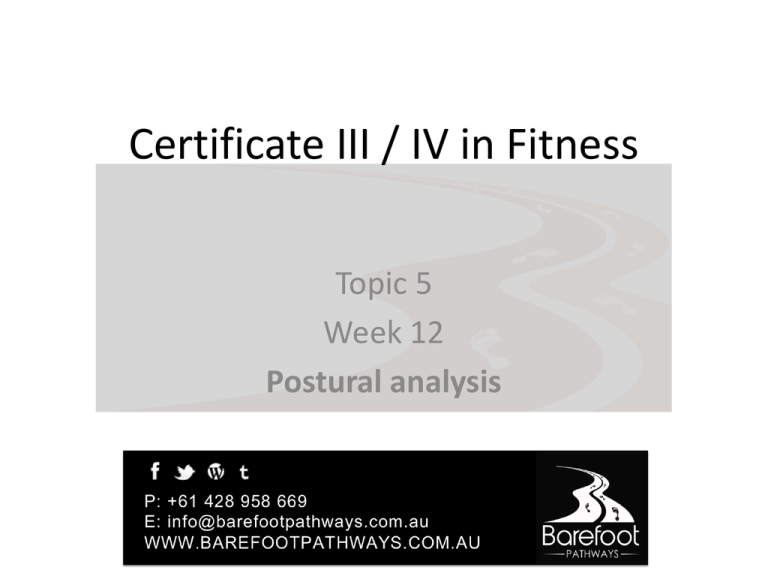
Certificate III / IV in Fitness Topic 5 Week 12 Postural analysis Session 4 & 5 Todays session will cover the following topics Client postural screening • • • • Occupational influences on posture Range of movement Static postural analysis Dynamic postural analysis Weekly review Question time Postural appraisal for low-risk participants This session involves application of the following topics: introduction to postural appraisal postural variances range of movement assessment static posture assessment dynamic posture assessment. Postural appraisal for low-risk participants Aims of postural appraisal The aims of a postural appraisal will vary from client to client, but in general the overall focus is to: • identify abnormalities • determine the degree and origin of the deviation • determine the effect on proposed or current exercise plans and goals • identify contraindications and postural risk factors associated with exercise • identify postural risk factors associated with increased risk of injury Postural appraisal for low-risk participants – Posture is assessed in two different ways: • Static postural appraisal involves observations and measurements from the anterior, posterior and lateral views of a client. Generally it may include standing, sitting or lying positions • Dynamic postural appraisal involves the assessment of clients while they perform exercises or general movements and actions What is good posture? – Good posture, or ideal postural alignment, requires all body parts to be in good balance and harmony with each other – In this state, pressure and tension acting upon supporting structures (ligaments, tendons and cartilage) are minimal – Poor posture is less efficient than good posture and becomes less stable over its base of support What is good posture? – The muscular system should possess the strength and endurance to resist the force of gravity and other forces imposed on the body during muscular effort – The task for the fitness trainer is to identify and evaluate the muscles that are affecting the standard posture and to implement an exercise program designed to improve function – If dysfunction is the cause of continued pain or restriction, and the implementation of an exercise program has an element of risk or contraindication refer to AHP When should I refer? – The following flags will inform the decision to refer: • History of injury, musculoskeletal or nervous • Responses to questions relating to chronic conditions • Hypomobility/Hypermobility of joints • History of neck or back injuries • Current contact with an AHP Postural variances – The inhibition of specific muscles or a muscle group may lead to postural changes – Fitness trainers undertaking a postural appraisal should note that, when observing any dysfunction, the possibility of it being due to the inhibition of a single muscle is limited – There are various muscular tests available to identify potential muscle imbalance Postural variances – Areas above or below muscle inhibition can result in the displacement of the skeletal system or compensatory changes, including: • change in the centre of gravity, due either to weight adjustment or pregnancy • structural skeletal changes • joint impingement • joint compression • joint separation or stretching • joint hypermobility or hypomobility Muscle development and poor posture – One of the principle functions of muscles is to move the body and give support to the skeletal structure – muscular development will support the skeletal structure, soft tissue reliability and neurological control – Removal or breakdown in one of these factors may result in instability, weakness and, on occasion, injury Muscle development and poor posture – Example of poor posture: • If the hip flexors (iliopsoas and rectus femoris) are stronger than the hip extensors (gluteals and hamstrings) it will cause the joint to be held in a flexed position (anterior pelvic tilt) • Over time, the joint capsule and ligaments on the side of the flexors will become shortened, thicker and tight • When the extensors contract, they will be required to exert increased levels of force to stretch the shortened capsule and ligament • Very tight hip flexors may be a source of constant pain, severely limiting hip extension, adversely affecting function Occupational influences on posture – Considering that most people spend many hours at work, occupational influences can have a profound effect on posture – Reflect on the postural position you are currently in while reading this book: • Looking down continuously at reading material on a flat desk – as a student or office worker does, over many hours, day after day – place considerable tension on the neck, shoulders and back Occupational influences on posture – In order for the fitness trainer to develop an exercise program aimed at stretching and strengthening the affected muscles, it is imperative to first identify them – If the scapula becomes restricted, unstable due to rotator cuff dysfunction, or there is a muscle imbalance or weakness, this may impact on the shoulder rhythm or motion Occupational influences on posture – Sitting and manual handling: • Assessing a client’s sitting or lifting posture is especially important if much of your client’s time at work involves one of these activities • It is accepted that a seated posture will deviate from the optimum at times. However, it is important that a minimum amount of time is spent in these alternative, often poor postures Occupational influences on posture • If a person sits up straight, at a 90-degree angle, disc pressure is high. If a person leans forward while seated, thus decreasing the previous angle, disc pressure is greatly increased • Clients should be instructed to allow the vertebral column to lengthen into a natural position, as it would in a standing position • Sitting with a slight lean backwards anteriorly rotates the pelvis, thus reducing disc pressure. In this position the vertebral column assumes its normal ‘S’ curve Occupational influences on posture • There are two common mistakes people make when lifting objects: – The first one is using the wrong muscles. People often rely on the strength and endurance capacity of the back musculature rather than that of the legs and buttocks – The second mistake is attempting to lift an object that is too far from the body or reaching out in front of the body with a weight Exercise and poor posture – Incorrect training techniques, muscular imbalance, non-adherence to fundamental training principles and numerous other factors will have an impact on posture – Sportspeople with a lordotic posture may experience a loss of efficiency and possible complications in the knees, hip and/or lower back. Muscles that are often tight with lordosis are: • trunk extensors (erector spinae and quadratus lumborum) • hip flexors, particularly iliopsoas (rectus femoris is the third hip flexor) Exercise and poor posture – Fitness trainers incorporating leg raises, hanging leg raises, sit-ups (legs anchored) or straightlegged sit-ups are accentuating the lordotic condition by further strengthening the hip flexors. The more appropriate program would include the following stretches: • trunk extensor (erector spinae and quadratus lumborum) • hip flexors (in particular the iliopsoas muscle) Footwear and poor posture – Wearing supportive footwear when standing or participating in exercise is important for good posture – Continually wearing high-heeled shoes, for example, may: • lead to the development of bunions, claw toes and corns and thickening of the nails • have ankles are placed in an unfamiliar position for extended periods, causing the Achilles and gastrocnemius to be held in a shortened position • move the knees and hips out of equilibrium, potentially causing the spine to exaggerate its curvature Footwear and poor posture – Flexibility is essential in the design and selection of footwear. There should be appropriate levels of lateral and longitudinal flexibility within a shoe – The desired level of flexibility will be determined by the purpose for which the shoe is to be used – Generally footwear should: • fit correctly • provide shock absorption • provide stability for side-to-side movements Age and poor posture – In many elderly people, there is; – increased thoracic kyphosis and a flattening of the lumbar curve – either posterior pelvic tilt or a compensatory increase in lumbar lordosis – the hip and knee joints become increasingly flexed with the ankle dorsi flexed to counter these changes – Generally, there is a loss of height due to this imperfect posture – Exercise in the opposite direction to the bending at a joint is advisable in order to regain better posture Obesity and poor posture – In obese people, there can be; – weak and often protruding abdominal muscles can prevent maximum expiratory pressure – altered pulmonary mechanics and as a result less oxygen is delivered to working muscles – muscle atrophy which is a precursor to postural change and associated injury – Exercise designed to promote a positive lifestyle and behavioural changes Pregnancy and poor posture – During pregnancy, there can be; – rapid weight gain associated with pregnancy, along with altered weight distribution – with the development of the foetus, the centre of gravity shifts forward and upward. The common outcome of this is usually an increase in lumbar lordosis and compensatory thoracic kyphosis – any muscular adaptations will be further compounded by breast enlargement – The focus of the fitness trainer is instruction in proper postural habits, which will minimise strain, especially on the back, and the risk of injury Legislation and regulatory requirements – A fitness trainer must obtain informed consent as part of the client induction process • should happen via the client reading the document, or the trainer reading it out loud • the client must sign that they agree to the document – The fitness trainer must always explain the postural appraisal process clearly and completely. Particularly in relation to the reason for privacy during screening – The trainer must also explain the recording of deviation Legislation and regulatory requirements – What is the Privacy Act? • The federal Privacy Act 1988 governs the collection, use, disclosure, quality and security of personal information • With respect to postural screening this would relate to the capture of photographs/images and information about the client – Child protection • as a fitness trainer you should always be aware of your states legislation with respect to child abuse and reporting Assessing range of movement – An individual’s range of movement (ROM) describes the degree to which a joint can move – ROM varies from joint to joint. A subjective assessment of an individual’s ROM in any particular joint is easily achieved by comparing it with the other side – Range of movement screening will help you decide if goniometric measurement is required Assessing range of movement – Using a goniometer • A goniometer is a device that measures, in degrees, a joint’s angle or ROM. It does not identify the cause of any limitations in that joint • For the fitness professional the main benefits of quantifying this information are to: – measure the progress in the return to either ROM or functional movement which is free from limitation or pain, or – identify any abnormal or restricted ROM that may need further investigation by a suitably qualified health professional. Assessing range of movement – A traditional goniometer is a protractor with extending arms. The following steps will assist fitness trainers assess accurately: 1. Place the axis of the goniometer with the axis of rotation for that joint with the stationary arm along the stationary line of the body and the moveable goniometric arm along the moveable portion of the body 2. Record the starting position, in degrees 3. Instruct the client to move their joint in the desired direction according to their full ROM 4. As the client has reached their furthest ROM for that joint, record this reading from the goniometer 5. Comparisons can be made with standard values or, alternatively, comparisons can be made with the opposing joint Static postural assessment – When assessing a client’s static posture, fitness trainers have the option of using a range of equipment (e.g. plumb line, posture grid, video cameras or computer programs) – Understanding the processes involved in lowtech postural assessment will more likely provide the fitness trainer with the confidence and competence to apply postural analysis in the workplace Static postural assessment – When assessing a client’s static posture, fitness trainers have the option of using a range of equipment (e.g. plumb line, posture grid, video cameras or computer programs) – Understanding the processes involved in lowtech postural assessment will more likely provide the fitness trainer with the confidence and competence to apply postural analysis in the workplace Static postural assessment – When conducting a postural assessment, following a set procedure helps improve the reliability and validity of the results: 1. Select a flat surface for the client to stand on 2. Ask the client to wear minimal clothing (e.g. swimwear). This allows for unrestricted observation 3. Ask the client to take up a neutral stance on a line marked on the floor in front of the posture grid or screen 4. Suspend a plumb line just in front of this line 5. Take up a position that provides a clear and unrestrictive view of the client – no less than 3 m from the client should be satisfactory 6. Ask the client to relax and breathe normally Impact of non-ideal postural alignment – In the ideal postural alignment stance the tension placed on the musculoskeletal system is minimal, allowing an individual to stand relaxed in their typical position – A non-ideal postural alignment can affect the range of movement of muscles and joints, as well as overall functional capacity – Fitness trainers must have a solid understanding of the musculoskeletal system, as correct identification, location and action of the inhibitive muscle (or muscle group) will have obvious consequences on exercise selection Postural examination – When examining a client’s posture, it is necessary to be prepared. Developing competency in postural screening requires practice and the use of a set procedure – Clients who are left standing in a static position for an extended period may begin to fatigue and succumb to strain or nervous tension – Completing the examination quickly and accurately allows you to move on to the next stage of the client screening process. Therefore, it is important to become proficient in examining clients Postural examination – The Anterior and Posterior view: • if using a plumb line or assessment grid; – have the client stand behind it for the Anterior view, and in front for the Posterior – ensure the client is not touching the line/grid – instruct them to have their arms relaxed, with hands neutral • use a recording sheet which will allow the trainer to identify all anatomical segments and important deviations Postural examination – The Lateral view: • for this view the client should stand with the plumb line/grid to their side • the client should stand in the same position as for the anterior/posterior observation • use a recording sheet which will allow the trainer to identify all anatomical segments and important deviations Static postural deviations of the spine – Lordosis: • increased curvature of the spine, usually lumbar. • can also affect thoracic and cervical areas of the spine • Lumbar lordosis relates to pelvic deviation (anterior/posterior tilt) – Kyphosis: • increased posterior curvature of the spine, usually thoracic. • can be from structural (eg shape of spine) or functional (eg work habit) issues • chest muscles are often tight, erector spinae, rhomboids and trapezius week Static postural deviations of the spine – Scoliosis: • vertebrae with a lateral deviation • will appear with lateral flexion and rotation of vertebrae • two types; – C curve: single curve – S curve: two curves Static postural deviations of the pelvis – The pelvis is in a natural position when the anterior superior iliac spine (ASIS) and the symphysis pubis are in vertical alignment • An anterior pelvic tilt refers to a position in which the ASIS is forward, or anterior to the vertical plane • A posterior pelvic tilt is a position where the ASIS is posterior to the vertical plane • A lateral pelvic tilt is present when there is an obvious side lean of the pelvis Static postural deviations of the legs – Genu valgum (knock-knees) is the slanting of the knees either unilaterally or bilaterally towards each other • may be developed or retained from; – – – – trauma to growth cartilage congenital anomalies genetic disorders metabolic bone disease – Gena varum (bowed legs) is observed when the feet and ankles remain together and knees wide apart. Infants are born with bowed legs Static postural deviations of the legs – Genu recurvatum (knee hyperextension) is the posterior bowing of the knees while in a standing position • may be functional or congenital from; – poliomyelitis – fibrosis – trauma to growth cartilage – limb length discrpancies Static postural deviations of the scapulae – The scapulae should sit nicely against the rib cage wall, forming the scapulothoracic joint – If the scapulae are protruding posteriorly from this position, it is known as scapular winging – Scapular winging is often associated with nerve pathology and involves weakening of the surrounding musculature, including; • rhomboids and, in particular, the lower portion of the serratus anterior Dynamic postural assessment – As an extension to the static postural evaluation, dynamic posture can be considered as a series of movements that are linked to produce a degree of effort – The purpose of a dynamic postural assessment is to observe how the body responds to movement under a reduced load, that being the force of gravity – The trainer could carried out a dynamic postural assessment via; running, walking, placing clothes on a line, picking up children, lifting a box, weightlifting Dynamic postural assessment – Assessing dynamic posture: • the key purpose is to identify bilateral imbalance, fault or instability • some examples of assessments; – overhead squat – single leg raise assessment (Trendelenburg test) – single leg squat assessment – pushing movement assessment – pulling movement assessment Take home message from todays session: • This might be an area that scares the crap out of you, but once conquered can help build your confidence tenfold! • Occupational influences on posture • Range of movement • Static postural analysis • Dynamic postural analysis Take home message from todays session: • For all of the new methods that you have been shown in the strength and conditioning sessions, please review and explore in more details to develop your own specialised understanding. • Try to choose an area of interest and pursuit it!
